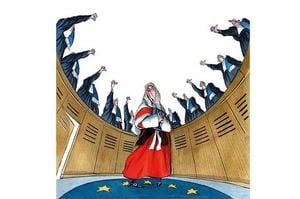Small business owners across the United States are entering the final stretch of 2025 with a mix of optimism and caution, as a series of new reports and surveys paint a nuanced portrait of their expectations, challenges, and hopes for the remainder of the year. The latest data, released in early September, reveal that while confidence has ticked up in some areas, concerns about inflation, hiring, and uncertain demand continue to weigh on the minds of entrepreneurs.
According to Liz Ann Sonders, a well-regarded market strategist, the August National Federation of Independent Business (NFIB) Small Business Optimism Index rose to 100.8, up from 100.3 in July and outpacing the market estimate of 100.5. This figure, reported on September 9, 2025, marks a modest but meaningful improvement, keeping the index above its long-term average of 98. Sonders highlighted that this uptick was driven in part by a slight increase in small business hiring plans and a notable decline in the percentage of firms expecting to raise their selling prices. However, she also pointed out that the net share of businesses anticipating an improved economy had actually dipped, underscoring the mixed signals that characterize the current economic landscape.
The NFIB’s own detailed breakdown of its August survey helps flesh out the story. The index’s rise was largely propelled by a six-point gain in the share of owners expecting higher real sales—a sign that many business leaders believe consumer demand could strengthen in the coming months. Yet, the survey also revealed a slowdown in price pressures: only a net 21 percent of owners reported raising their average selling prices, down three points and representing the lowest reading so far this year. Planned price increases also eased, with just 26 percent of owners expecting to charge more in the next three months. This cooling of price hikes comes as just 11 percent of survey respondents named inflation as their top problem, a figure that has remained unchanged for three consecutive months.
These results challenge the narrative that tariffs and rising input costs would quickly translate to higher consumer prices or disproportionately squeeze small businesses. Instead, the NFIB found that owners are reporting stronger earnings even as price increases have slowed. In fact, a net negative 19 percent of owners reported lower earnings—the best reading since March 2023. For those businesses that did see profits rise, nearly two-thirds attributed their gains to stronger sales volumes rather than simply charging more for goods and services.
Credit conditions have also offered a bit of relief. The average rate paid on short-term loans declined to 8.1 percent in August, the lowest level since May 2023. This reduction in borrowing costs has helped many businesses absorb higher input expenses without immediately passing them on to customers. Still, the mood around capital investment remains subdued. Only 56 percent of owners said they had made capital outlays in the past six months, a historically low figure even with improved earnings and sales expectations. It suggests that, despite healthier short-term profits, many business owners remain cautious about making long-term bets on expansion.
Labor quality, meanwhile, remains a persistent thorn in the side of small businesses. In August, 21 percent of owners cited it as their most pressing concern, and about a third of firms reported unfilled job openings—the lowest share since 2020 but still a significant hurdle. Compensation plans have edged higher as businesses try to attract talent, but many owners continue to say that a lack of qualified workers is limiting their ability to hire.
The findings from the NFIB and Sonders’s analysis dovetail with a recent survey by NEXT Insurance, which polled 1,500 business owners about their outlook for the remainder of the year. The survey, published on September 9, 2025, found that just under half (49 percent) of respondents expect their profits to increase by the end of 2025—a six-point drop from the 55 percent who felt optimistic at this time last year. The share of business owners who expect no change in profits jumped from 27 percent in 2024 to 35 percent in 2025, while those expecting profit shortfalls dipped slightly from 18 percent to 16 percent. These numbers suggest a growing sense of caution, as more owners brace for steady or stagnant results rather than betting on robust growth.
Inflation concerns, according to the NEXT Insurance survey, have reached record highs among small business owners. Rising costs and slowing demand have muddied the economic outlook, prompting many owners to keep a close eye on broader trends before making aggressive moves. Investment spending has remained largely flat across key areas such as customer acquisition, product and service development, equipment and technology, hiring and retaining staff, and risk management. The most notable shift was a 3 percent increase in hiring and retraining employees compared to last year.
Interestingly, while the percentage of business owners who said they planned to hire in 2024 and 2025 stayed flat, those intending to bring on larger numbers of workers has grown. Thirteen percent of business owners planning to hire said they would add 10 or more new employees, and 12 percent planned to hire six to 10 new workers—both figures up 3 percent from last year. Conversely, the share of owners hiring just one to five new employees dropped by 5 percent. Not every employer is looking to expand their workforce, though: 26 percent said they don’t need to hire, and 18 percent said they can’t afford to, both figures roughly consistent with last year.
One bright spot in the labor market is that it seems to be getting easier to find talent. Only 8 percent of owners said they are not hiring in the final months of the year because it’s too hard to find employees—a significant improvement from the 15 percent who cited this problem in 2024.
Looking back at the first half of 2025, 22 percent of businesses exceeded their profit expectations, up from 20 percent last year. The largest group—42 percent—said profits met expectations, while 36 percent reported worse-than-expected profits, down from 38 percent in 2024. These results align with broader national trends reported by the Federal Reserve in 2024, which found that 46 percent of small businesses turned a profit, 35 percent operated at a loss, and more reported revenue declines than gains for the first time since 2021.
All told, the picture for small businesses heading into the closing months of 2025 is one of cautious optimism tempered by real concerns. While some signals—like improved sales expectations and easier hiring—point to brighter days ahead, persistent worries about inflation, labor quality, and flat investment spending suggest that many owners are holding steady rather than betting big on expansion. As the all-important holiday season approaches, small business sentiment will be a closely watched barometer for the health of the broader U.S. economy.




